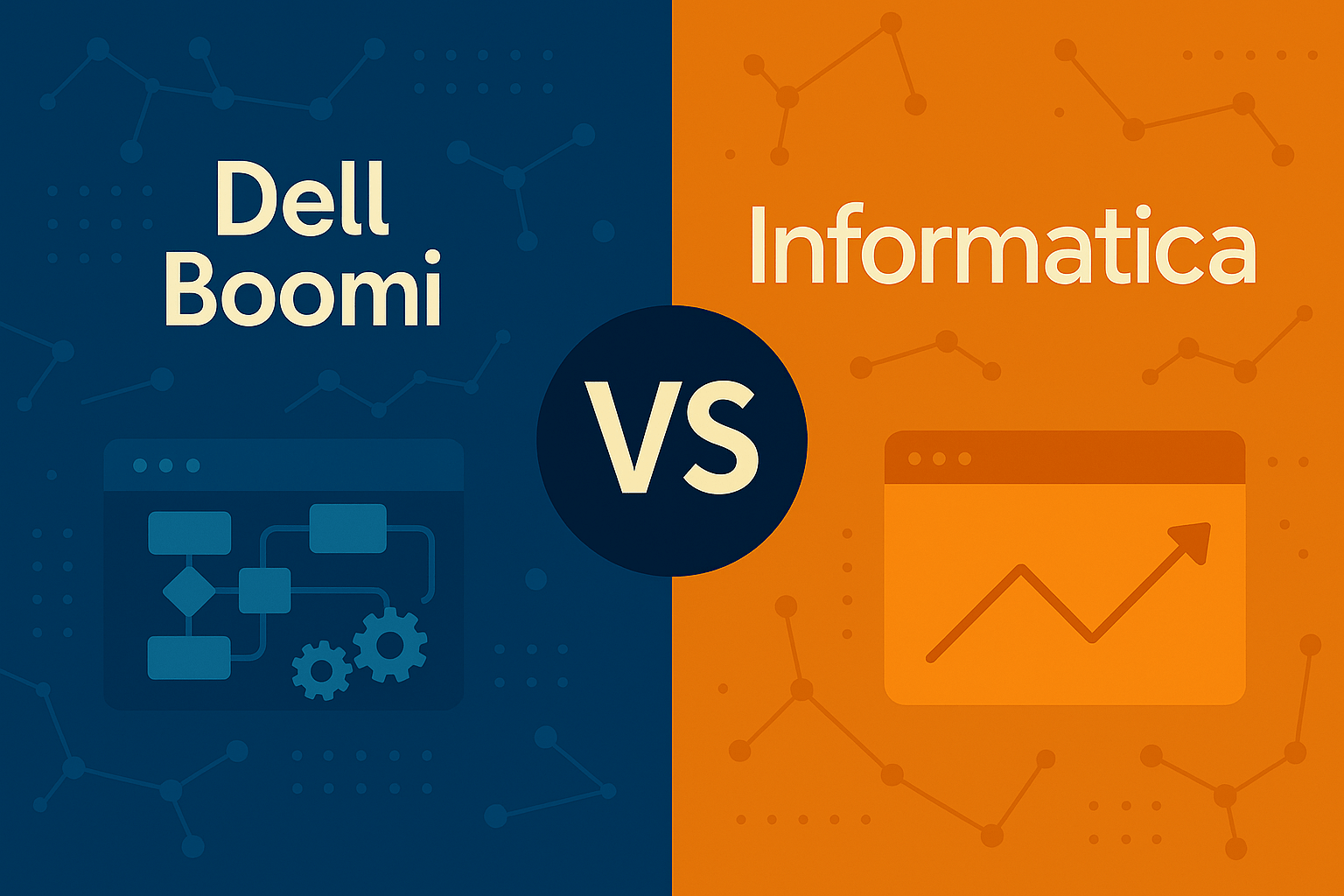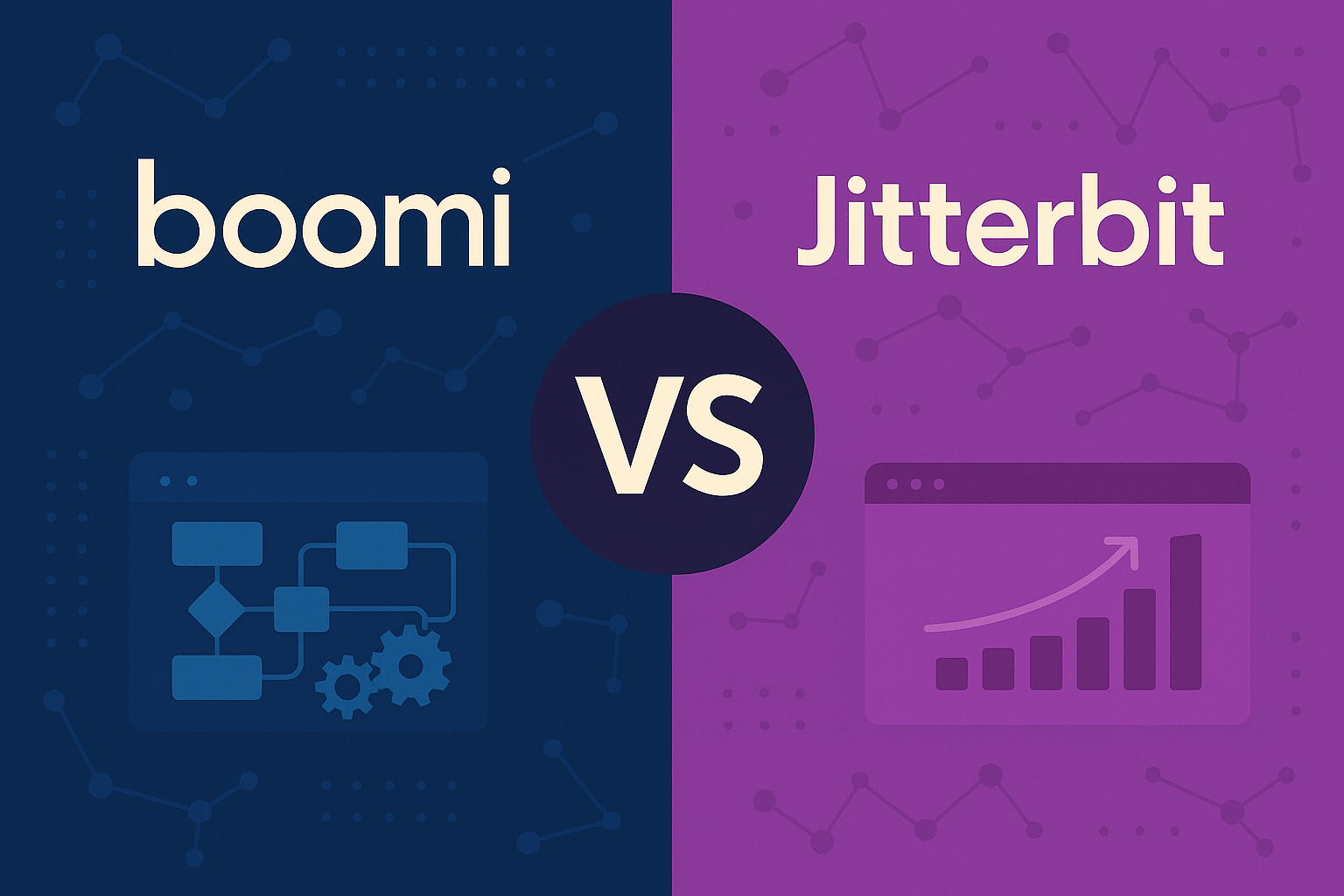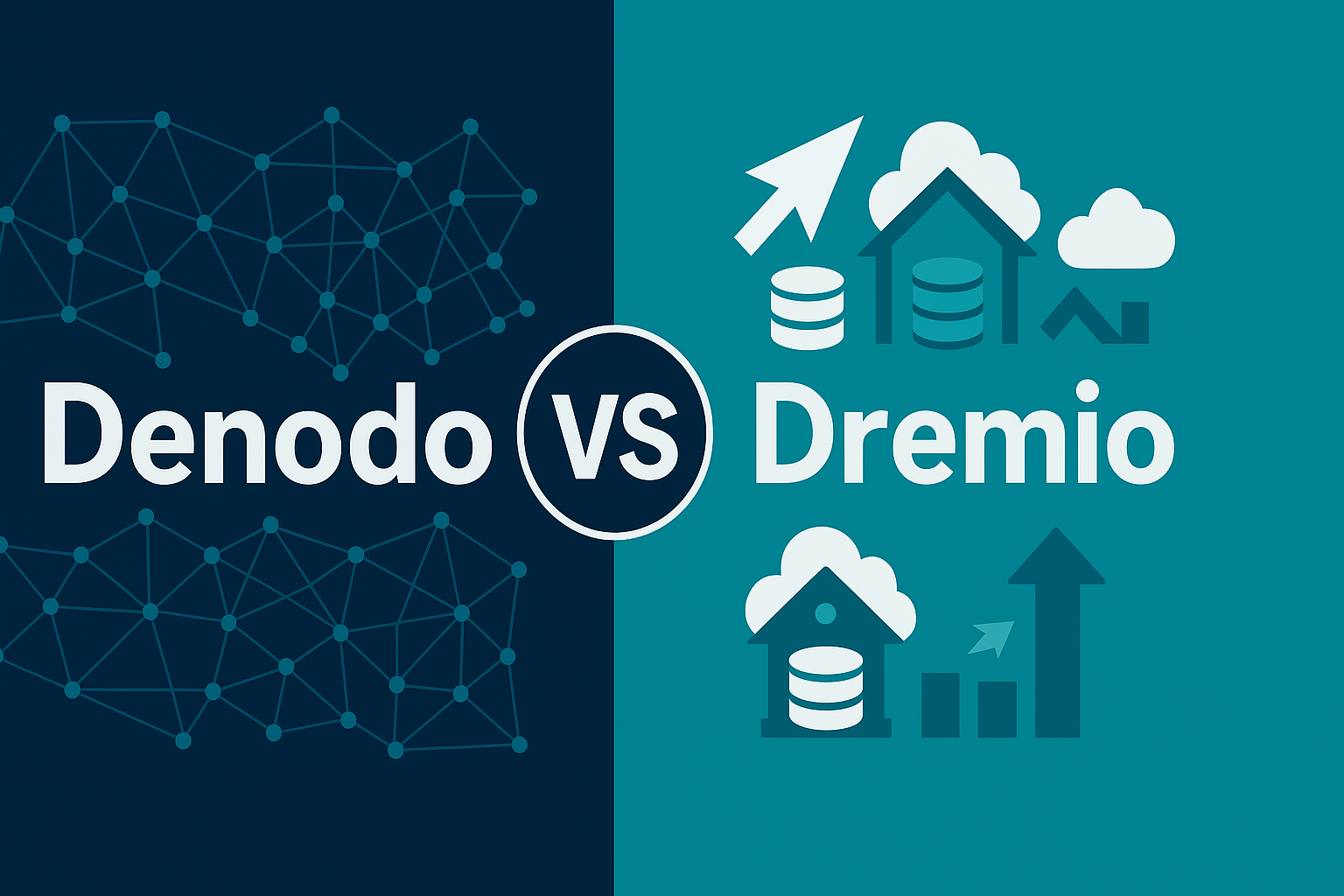Boomi vs Talend: Which Integration Platform is Right for You?
Choosing the wrong data integration platform can set your organization back months and cost thousands in wasted resources.
This comprehensive comparison will help you navigate the key differences between these platforms, understand their unique strengths, and make an informed decision based on your organization’s specific requirements.
Data Tool Comparison
|
Category |
Factory Thread |
Dell Boomi |
Talend |
|---|---|---|---|
|
Core Focus |
Real-time industrial integration (OT/IT) |
Managed iPaaS for rapid cloud integrations |
Enterprise data integration with deep transformation |
|
Best For |
Manufacturers needing shop-floor automation, MES/PLC sync |
Businesses seeking quick deployment and low-code tools |
Enterprises requiring complex data transformation and big data processing |
|
Pre-built Connectors |
Native OT systems: Siemens, Rockwell, OPC UA, SCADA |
240+ cloud and on-prem systems |
1000+ connectors including Hadoop, Spark, big data sources |
|
Interface |
Low-code visual builder designed for engineers |
Drag-and-drop UI for business and IT users |
Developer-focused; technical UI with full Java customization |
|
AI Features |
AI-generated flows for manufacturing logic |
Limited scripting assistance |
No AI, manual configuration for most flows |
|
Deployment Options |
Edge, on-prem, cloud with offline capability |
Cloud, hybrid, on-prem via Atoms/Molecules |
Cloud, on-prem, hybrid; Open Studio for self-managed setup |
|
Real-Time Capability |
Native real-time triggers (machine states, events) |
Real-time via Atoms |
Event-driven architecture with batch and stream processing |
|
Offline Execution |
Yes – run flows on local edge gateways |
No – cloud connectivity needed |
Limited – mostly cloud/on-prem infrastructure dependent |
|
Data Processing Power |
Real-time operational execution |
Standard transformation and data routing |
Advanced data transformation, big data handling (Spark, Hadoop) |
|
API Management |
Built-in REST, OData, GraphQL endpoints |
Full lifecycle API management |
Comprehensive API development and governance suite |
|
Monitoring & Alerts |
Real-time dashboards, anomaly detection for production |
Visual process monitoring, alerting |
Deep logging, audit trails, regulatory compliance reporting |
|
Learning Curve |
Minimal – OT-first, intuitive for shop floor teams |
Low for basic use, moderate for complex use |
Steep – requires strong data engineering skills |
|
Cost Structure |
Custom for industrial scale, scaled by factory footprint |
~$1,000/month; scales with usage |
Open source free tier, enterprise pricing for full features |
|
Use Case Strength |
ERP-MES sync, downtime tracking, edge workflows |
SaaS integrations, business process automations |
Data lakes, ETL pipelines, reverse ETL, healthcare, finance data ops |
|
Scalability |
Edge-native, horizontally scalable across plants |
High – atom-based horizontal scaling |
High – big data and event-stream optimized |
What Makes These Integration Platforms Unique?
Boomi – Managed Platform Excellence

Dell Boomi delivers a cloud native iPaaS solution designed for organizations prioritizing ease of use and rapid deployment. This platform excels at simplifying integration processes through its intuitive drag and drop interface, making it accessible to teams with varying levels of technical expertise.
Key benefits of Boomi:
-
User friendly drag and drop interface that reduces the learning curve
-
240+ pre built connectors for seamless system integration
-
Cloud native architecture with managed infrastructure
-
Rapid deployment capabilities that accelerate time-to-value
-
Strong workflow automation features for business process optimization
Boomi’s strength lies in its ability to democratize data integration, allowing both technical and non-technical users to create and manage integration workflows efficiently. The platform’s atom-based architecture provides flexible deployment options across cloud applications, on premise systems, and hybrid environments.
Talend – Enterprise Data Powerhouse

Talend offers comprehensive data integration capabilities spanning from open source solutions to enterprise-grade platforms. The Talend Data Fabric provides extensive customization options and advanced processing power that large enterprises require for complex data operations.
Key benefits of Talend:
-
1000+ connectors and processors for extensive system coverage
-
Advanced big data processing capabilities with native support for Hadoop and Spark
-
Sophisticated data transformation tools for complex business logic
-
Enterprise grade master data management and data quality features
-
Open Studio community edition providing good value for budget-conscious organizations
Talend’s architecture supports everything from simple data integrations to complex, event driven processing workflows. The platform excels in scenarios requiring detailed data governance, compliance management, and large datasets processing.
Boomi vs Talend: Technical Capabilities Comparison

User Interface and Ease of Use
Boomi prioritizes user experience with its visual, drag and drop interface. The platform’s low-code approach enables business users to participate in integration design without extensive programming knowledge. Users consistently praise Boomi’s intuitive workflow design and streamlined development process.
Talend offers a more technical, developer-focused interface optimized for complex data operations. While this provides greater control and customization options, it requires more technical expertise to fully leverage the platform’s capabilities. The learning curve is steeper, but the depth of functionality rewards experienced data integration teams.
Integration Capabilities and Connectors
|
Feature |
Boomi |
Talend |
|---|---|---|
|
Pre-built connectors |
240+ |
1000+ |
|
Custom connector development |
Limited scripting (Groovy, JavaScript) |
Full Java development capabilities |
|
Big data support |
Basic cloud integration |
Native Hadoop, Spark integration |
|
Real time data integration |
Supported via Atoms |
Advanced event driven processing |
|
API management |
Integrated lifecycle management |
Comprehensive API services |
Scalability and Performance
Boomi’s cloud native architecture automatically scales based on demand, with Atoms and Molecules providing distributed processing power. The managed infrastructure approach means organizations don’t need to worry about underlying technology maintenance, making it ideal for businesses seeking to minimize operational overhead.
Talend’s architecture supports both cloud and on prem deployments, offering greater control over performance optimization. The platform excels at processing large datasets and complex transformations, particularly in scenarios involving reverse ETL operations and high-volume data movement between systems.
Data Security and Compliance
Both platforms provide robust data security features, but with different approaches:
Boomi offers enterprise-grade security through its managed cloud infrastructure, including encryption, access controls, and compliance certifications. The platform handles security updates and maintenance automatically.
Talend provides granular security controls and supports comprehensive compliance frameworks. Organizations with specific regulatory requirements often prefer Talend’s detailed governance capabilities and audit trail features.
Pricing and Value Analysis
Boomi Pricing Structure
Boomi operates on a subscription-based model starting around $1,000 per month. The pricing scales based on the number of connections and data volume processed. While there’s no free tier, the managed infrastructure and support services provide significant value for organizations seeking predictable operational costs.
Talend Pricing Approach
Talend offers multiple pricing tiers:
-
Open Studio: Free community edition with basic integration capabilities
-
Enterprise editions: Custom pricing based on features and scale
-
Cloud solutions: Subscription-based with various service levels
The free Open Studio option provides excellent value for small teams or organizations wanting to evaluate Talend’s capabilities before committing to enterprise features.
Total Cost of Ownership
When comparing costs, consider these factors:
-
Boomi: Higher upfront subscription costs but lower operational overhead due to managed services
-
Talend: Potentially lower licensing costs (especially with Open Studio) but higher implementation and maintenance expenses
Large enterprises often find Talend’s total cost of ownership competitive when factoring in its advanced capabilities and customization options.
Decision Framework: When to Choose Each Platform
Choose Boomi if you need:
✅ Rapid deployment with minimal technical complexity
✅ User friendly tools accessible to business teams
✅ Managed infrastructure reducing operational burden
✅ Strong support for cloud applications and SaaS integration
✅ Streamlined workflows for standard integration scenarios
Boomi excels in environments where speed to market and ease of use take priority over deep customization. Organizations with limited data integration expertise or those seeking to enable business users in integration design will find Boomi’s approach particularly valuable.
Choose Talend if you need:
✅ Advanced data transformation capabilities for complex business logic
✅ Enterprise scale processing for large datasets
✅ Extensive customization options and open architecture
✅ Big data integration with native support for modern data platforms
✅ Comprehensive governance and compliance features
Talend is the preferred choice for organizations with sophisticated data requirements, experienced technical teams, and complex integration scenarios involving multiple data sources and transformation processes.
Real-World Use Cases and Success Stories
Boomi Success Scenarios
A mid-sized retail company used Boomi to integrate their e-commerce platform with inventory management and customer service systems. The drag and drop interface enabled their business analysts to modify integration workflows as requirements changed, reducing dependency on IT resources and accelerating process improvements.
Talend Implementation Examples
A healthcare organization leveraged Talend Data Fabric to consolidate patient records from dozens of legacy systems into a unified data warehouse. The platform’s advanced data quality tools ensured compliance with healthcare regulations while its big data capabilities handled millions of patient records efficiently.
Making Your Final Decision
The choice between Boomi vs Talend ultimately depends on your organization’s technical capabilities, integration complexity, and strategic objectives. Consider these key factors:
Team expertise: Boomi requires less technical knowledge, while Talend rewards deeper integration skills
Integration complexity: Simple to moderate complexity favors Boomi; complex transformations suit Talend
Budget considerations: Evaluate both licensing costs and implementation resources
Scalability requirements: Consider current needs and future growth projections
Vendor preferences: Factor in open source flexibility versus managed service convenience
Both platforms successfully handle data integration challenges, but their optimal applications differ significantly. Organizations prioritizing rapid deployment and user accessibility should lean toward Boomi. Those requiring maximum flexibility, advanced features, and enterprise-scale capabilities will find Talend better aligned with their needs.
Start by conducting a thorough assessment of your current systems, team capabilities, and integration requirements. Consider running proof-of-concept projects with both platforms to evaluate how well each aligns with your specific use cases and organizational culture.
The right integration platform becomes a strategic asset that enables better decision-making, improves operational efficiency, and supports business growth. Choose wisely, and your organization will benefit from seamless data flow and enhanced business processes for years to come.
Factory Thread: Integration Built for Real-Time Manufacturing, Not Just Data Pipelines
Boomi offers managed simplicity. Talend powers deep data transformation. But neither platform is built to handle the urgency and specificity of industrial integration. Factory Thread provides a third option—an integration layer tailored to the factory floor and real-time operational execution.
Unlike traditional iPaaS platforms focused on cloud apps or big data pipelines, Factory Thread connects directly to MES, PLCs, sensors, and industrial devices. It’s designed for shop-floor visibility, execution, and automation—where milliseconds matter and downtime costs real money.
Why Manufacturers Choose Factory Thread:
-
Industrial-Ready Connectors: Native support for Rockwell, Siemens, SCADA, OPC UA, and more—no custom coding or adapters required.
-
Low-Code for Engineers: A visual workflow builder tailored for OT teams—not just IT departments or developers.
-
Edge Execution: Deploy integration logic directly to local edge gateways, with offline capabilities for disconnected environments.
-
Event-Driven Actions: Automate based on real-time machine states, downtime triggers, sensor thresholds, or production shifts.
-
Factory-Native Use Cases: Streamline OEE tracking, downtime response, ERP-to-MES syncing, and maintenance alerts—out of the box.
Factory Thread isn’t trying to be everything to everyone—it’s purpose-built for operational excellence in manufacturing. For organizations where data doesn’t just inform decisions, but drives immediate action on the line, Factory Thread delivers speed, simplicity, and control that Talend and Boomi weren’t designed to offer.
Share this
You May Also Like
These Related Stories

Boomi vs Informatica: Which Integration Platform is Right for You?

Dell Boomi vs Jitterbit: Which Integration Platform is Right for You?



No Comments Yet
Let us know what you think